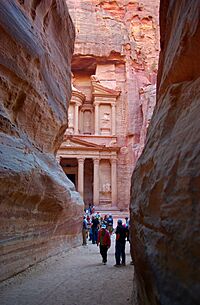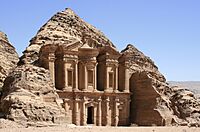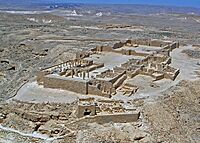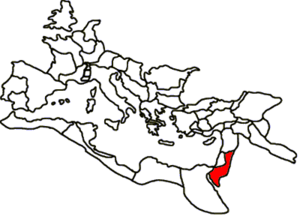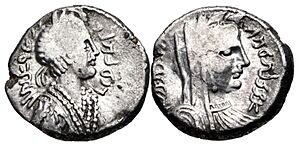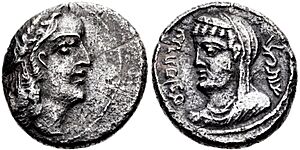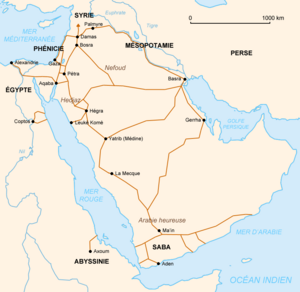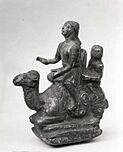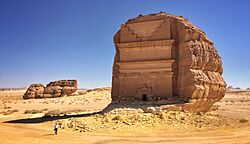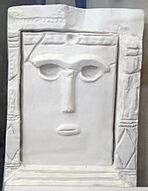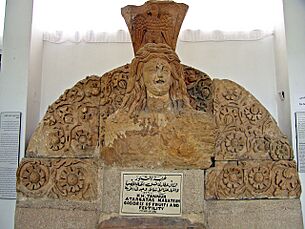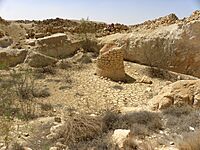Nabataeans facts for kids
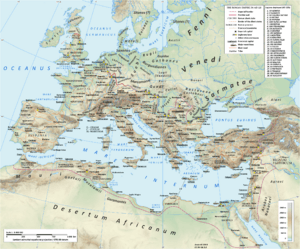
A map of the Roman empire under Hadrian (ruled CE 117–138), showing the location of the Arabes Nabataei in the desert regions around the Roman province of Arabia Petraea (lower-right)
|
|
| Languages | |
|---|---|
|
|
| Religion | |
|
|
| Related ethnic groups | |
| Arabs |
The Nabataeans were an ancient Arab people. They lived in parts of northern Arabia and the southern Levant. Their most famous city was Raqmu, known today as Petra in Jordan. This city was likely their capital. The area they lived in was called Nabatene. It stretched from the Euphrates River to the Red Sea.
The Nabataeans became a strong civilization and political group between 400 and 200 BCE. Their kingdom was built around a large trading network. This network brought them great wealth and power across the ancient world.
Ancient Greek and Roman writers described the Nabataeans as very independent. The Roman Empire, led by Emperor Trajan, took over their kingdom in 106 CE. Over time, the Nabataean culture, known for its beautiful pottery, blended with the larger Greco-Roman culture. They later became Christians during the Later Roman Era. Many people see them as one of the most talented and "unjustly forgotten" peoples of the ancient world.
Contents
History of the Nabataeans
Early Beginnings
The Nabataeans were an Arab tribe. They were greatly influenced by the Babylonians and Arameans. The first time we hear about the Nabataeans is around 312/311 BCE. An officer named Athenaeus, working for Antigonus I, attacked them. This attack happened at Sela or perhaps Petra, but it was not successful.
Around 50 BCE, the Greek historian Diodorus Siculus wrote about them. He mentioned that just as the Seleucids tried to control them, the Romans also tried to gain control of their valuable trade.
The Nabataeans used Syriac letters to write to Antigonus. Aramaic remained the language on their coins and inscriptions. As their tribe grew into a kingdom, they became richer. They expanded their land northward, especially east of the Jordan River. They took over Hauran. Around 85 BCE, their king Aretas III became ruler of Damascus and Coele-Syria.
The Nabataean Kingdom
The city of Petra grew quickly in the 1st century BCE. Its population reached about 20,000 people.
The Nabataeans were friends with the early Hasmoneans. They helped them fight against the Seleucid rulers. Later, they became rivals of the Judaean dynasty. This rivalry caused problems that led to the Roman general Pompey getting involved in Judea.
King Obodas I defeated the Judaean army in 90 BCE. The Roman military did not have much success against the Nabataeans. In 62 BCE, a Roman leader named Marcus Aemilius Scaurus ended his siege of Petra. He accepted a large payment, partly because the land was difficult and he was running out of supplies. King Aretas kept his lands, including Damascus, and became a Roman ally.
Later, during the reign of King Malichus I, Herod the Great fought a war against Nabataea. Herod's army took over some Nabataean towns. After an earthquake in Judaea, the Nabataeans rebelled. Herod's army then defeated them in battle.
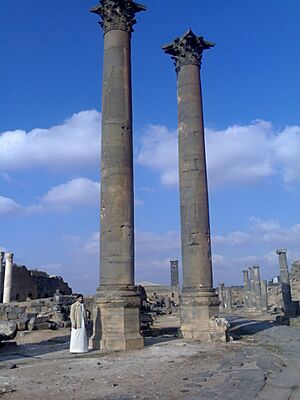
King Aretas IV of Nabataea later defeated Herod Antipas. Herod Antipas was the son of Herod the Great.
Roman Influence
As an ally of the Roman Empire, the Nabataean kingdom thrived during the 1st century CE. Its power reached far into Arabia along the Red Sea. Petra was a busy trading center. However, its trade lessened as new routes opened up.
Under the Roman peace, known as the Pax Romana, the Nabataeans became less warlike. They focused on trade and farming. Their kingdom acted as a protective barrier between Rome and the desert tribes. However, Emperor Trajan eventually conquered Petra. He turned the Nabataean kingdom into the Roman province of Arabia Petraea.
By the 3rd century, the Nabataeans stopped writing in Aramaic. They started using Greek instead. By the 5th century, they had become Christians. When new Arab invaders arrived, the Nabataeans had mostly become peasants. Their lands were divided among new Arab kingdoms. The city of Petra was rediscovered by a Swiss explorer in 1812.
Nabataean Culture
Many examples of writings and drawings show the reach of Nabataean culture. These writings, mostly names and greetings, show that many people could read and write. However, very little Nabataean literature has survived.
Ancient writers like Diodorus Siculus described the Nabataeans. They suggested that the Nabataeans kept their trade routes and the origins of their goods secret. They even made up stories to hide this information.
Diodorus Siculus described them as a strong tribe of about 10,000 warriors. They were leaders among the nomads of Arabia. They avoided farming, permanent houses, and wine. Instead, they raised animals and traded valuable goods. They traded frankincense, myrrh, and spices from Arabia Felix (modern Yemen). They also traded bitumen from the Dead Sea with Egypt. Their dry land protected them. They dug bottle-shaped cisterns to collect rainwater. These cisterns were carefully hidden from invaders.
An early Arabic cookbook, Kitab al-Tabikh, includes a recipe for Nabataean water bread. This bread was made with high-quality wheat flour and baked in a tandoor oven.
Women in Nabataean Society
Based on coins, inscriptions, and other ancient writings, Nabataean women had many legal rights. Inscriptions on tombs show that men and women had equal property rights. Women also had rights in inheritance matters. They could make decisions about their own property. This was different from how women were treated in neighboring societies.

Women also took part in religious activities. They had the right to visit temples and offer sacrifices.
Archaeological findings suggest that Nabataean women played a role in social and political life by the 1st century CE. Nabataean queens were shown on coins, sometimes alone and sometimes with their king. This suggests they ruled together. It also shows that queens and other royal women had political importance. Other Nabataean women likely benefited from this as well.
While Nabataean culture seemed to prefer male rulers, it is possible that marrying a royal woman helped a ruler's position. This was similar to the Ptolemaic dynasty and Seleucids. The Nabataean royal family later adopted sibling marriage.
Nabataean women lost many of their rights when the kingdom came under the influence of the Roman Empire and Roman law.
Fashion and Clothing
Not much is known for sure about ancient Nabataean fashion before Greek and Roman influences. However, clothes and textiles found in graves suggest that their clothing was similar to their neighbors, the Judaeans. This was true during the 1st and 2nd centuries CE. It is hard to know what they wore earlier, as their art before this time did not show figures.
Common colors for textiles included yellow from saffron and bright red from madder. Blue fabrics were also found.
Nabataean men likely wore a tunic and a mantle, both made of wool. The tunic was in a Roman style (sleeveless), and the mantle was in a Greek style. This shows popular styles rather than unique Nabataean clothing.
Nabataean women wore long tunics with scarves and mantles. These scarves were loosely woven and had fringes.
The upper class of Nabataean society showed strong Greek and Roman influences. Kings on coins are shown clean-shaven with long, curled hair. Queens are shown wearing head coverings with curled hair and long, high-necked garments. Purple cloth seemed to be linked with the king.
Language of the Nabataeans
Historians believe Nabataeans spoke Arabic as their native language. However, for formal uses and inscriptions, they used a form of Aramaic. This Aramaic was heavily influenced by Arabic words. When talking with other Middle Eastern peoples, they used Aramaic. Aramaic was the common language for trade and official matters across the region.
The Nabataean alphabet developed from the Aramaic alphabet. It used a special cursive writing style. The Arabic alphabet later came from this Nabataean script. Many experts agree on this connection.
In old Nabataean documents, Aramaic legal terms are followed by their Arabic meanings. This might mean that Nabataeans used Arabic in their legal discussions but wrote them down in Aramaic.
Nabataean Religion
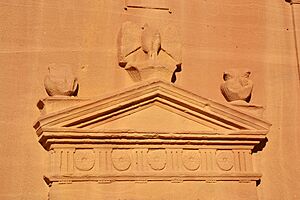
The Nabataeans traded widely, which led to different cultural influences. Their main gods were Dushara and Al-‘Uzzá. Dushara was the most important god of the Nabataean Arabs. He was the official god of the Nabataean Kingdom. His special status is shown in writings that call him "The god of our lord" (the King).
The name Dushara means "the one of Shara." Shara is a mountain range southeast of Petra. So, Dushara was likely linked to the heavens. The eagle was one of Dushara's symbols. It was often used in Hegra to protect tombs from thieves.
Writings from Hegra suggest Dushara was linked to the sun or the planet Mercury. Another Arabian god, Ruda, was also linked to Mercury. Dushara's "throne" is often mentioned in writings. Some think this refers to Dushara's wife, the goddess Harisha, who was probably a sun goddess.
Al-Uzza is thought to be Dushara's partner in Petra. Some believe the Temple of the Winged Lions was dedicated to Al-Uzza. This is because if the Qasr al Bint temple was for Dushara, then the other major temple might be for Al-Uzza. This is a theory, but it is likely that the temple was for the most important goddess of the Nabataeans. An "Eye Baetyl" or "Eye-Idol" was found at the Temple of the Winged Lions.
Many Nabataean sculptures of the goddess Atargatis were found. Atargatis was combined with the worship of Al-‘Uzzá.
Even after the Romans took over the Nabataean Kingdom, Dushara remained important. He was celebrated in Bosra by having coins made in his name. This happened during the 1000th anniversary of Rome's founding. He was honored by an Arabian emperor, Philip the Arab, using his Arabian name but in a Greek style.
Other gods worshipped in Nabataea included Isis, Balshamin, and Obodat.
Animal sacrifices were common. The Nabataeans often showed their gods as simple pillars or blocks. Their most common monuments were "god blocks." These were made by cutting away the top of a hill or cliff face, leaving only a block. Over time, the Nabataeans were influenced by Greece and Rome. Their gods then started to be shown with human features.
Nabataean Agriculture
Even though it was not as dry as today, the Nabataean area was still a desert. They needed special ways to farm. One method was to shape a piece of land into a shallow funnel. They would plant a single fruit tree in the middle. Before the rainy season, which might have only one or two rainfalls, they would loosen the soil around the tree. When it rained, all the water in the funnel would flow to the tree and soak into the ground. The soil, mostly loess, would then seal up and hold the water.
In the 1950s, a research team studied Nabataean farming near Avdat. They found that the Nabataeans collected rainwater runoff. This system concentrated water from a large area into a smaller one for crops. Another study looked at how they managed soil. It suggested that their farming systems helped gather more soil in wadis (dry riverbeds) to create farmland.
Famous Nabataean Architects
- Apollodorus of Damascus - A Greek-Nabataean architect and engineer from Damascus. He was very popular in the 2nd century CE. He is one of the few ancient architects whose name we still know. He brought new ideas from the East into Roman building styles, like making the dome a standard feature.
- Wahb'allahi - A stonemason from the 1st century who worked in Hegra. He was the brother of 'Abdharetat and father of 'Abd'obodat. He is mentioned in an inscription as the stonemason for the oldest dated tomb in Hegra.
- 'Abd'obodat son of Wahballahi - A 1st-century Nabataean stonemason who also worked in Hegra. He is named on five tomb facades as the craftsman. These tombs date to the reigns of kings Aretas IV and Malichus II. 'Abd'obodat was a successful craftsman. He continued the work of his father and uncle. He is seen as a main leader of one of the two major schools of Nabataean stonemasons.
- 'Aftah - A Nabataean stonemason who became well-known in the early 1st century CE. 'Aftah is mentioned in inscriptions on eight tomb facades in Hegra. He also worked on one grave. These facades date to the late reign of King Aretas IV. He sometimes worked with other stonemasons. He is the main leader of another stonemason school in Hegra.
- Halaf'allahi - A Nabataean stonemason who worked in Hegra in the 1st century. Halaf'allahi is named on two graves as the stonemason during the reign of King Aretas IV. He worked with 'Aftah on one grave. Nabataean architects were like contractors. They agreed on prices for different tomb types and their decorations. Tombs were built based on what the owners wanted and could afford. Halaf'allahi worked on both simple tombs for ordinary people and more complex tombs for military officials.
Places to Visit
- Jordan
- Raqmu (Petra) and Little Petra/Siq al-Barid
- Khirbet edh-Dharih, an ancient settlement and holy place
- Khirbet et-Tannur, a temple
- Sela (Edom), a mountaintop site
- Wadi Rum, a temple
- Syria
- Bosra
- Northwest Saudi Arabia
- Dumah (Dumat al-Jandal/Jawf), a trade center
- Hegra (Mada'in Saleh)
- Jabal al-Lawz
- Negev Desert, Israel
- Incense Route – Desert Cities in the Negev:
- Obodas (Avdat), a city with a Nabataean temple
- Elusa (Haluza), a town and road station
- Mampshis (Mamshit), a road station
- Shivta, a Byzantine farming town with earlier Nabataean and Roman parts
- South Sinai, Egypt
- Dahab: an excavated Nabataean trading port
See also
- List of Nabataean kings
- Azd, an ancient Arab tribe


